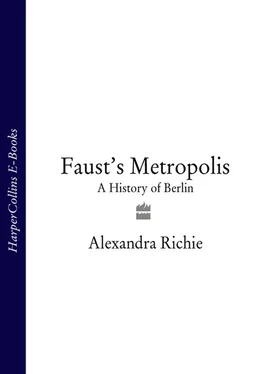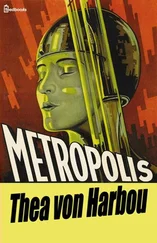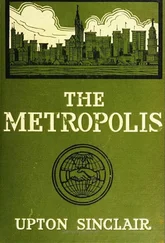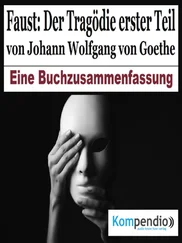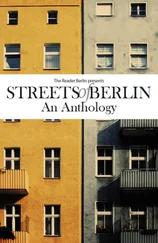1 ...8 9 10 12 13 14 ...30 This so-called ‘ Ostalgia ’ – nostalgia for the east – has become the new scourge of Berlin, turning the city into a battleground over the history of the GDR. It has already had an effect on post-Wall planning and reconstruction: bitter arguments have erupted over what to do with that symbol of the old regime, the Palast der Republik on Unter den Linden.
It is a plain rectangular structure with square, copper-coloured glass windows and white walls and lies in the midst of the few remaining old buildings in the heart of Berlin. It is a perfect symbol of the GDR, epitomizing the lack of creativity, the dearth of compassion and the insensitivity to the past which characterized the bankrupt regime; indeed it stands on the site of the former palace which was blown up for ideological reasons by Walter Ulbricht in 1950. The Palast also represented the powerlessness of East German citizens: it was built as a ‘people’s palace’ open to all ordinary citizens in order to show them that they were participants in the running of ‘their’ state. In reality, however, ordinary people had no access to power at all – indeed they rarely saw their leaders except on carefully staged ceremonial occasions, and political activity was forbidden unless specifically sanctioned by the SED. When the Wall fell it was understood that the Palast would be demolished and that some sort of building recapturing the proportions and facade of the old palace would go up on this historic spot; supporters of this idea had a life-sized mock-up of the old building painted on to vast canvas sheets and erected them at the site in 1993. But then Ostalgia struck. Suddenly the Palast der Republik was called a ‘monument’ to the people of the GDR; some easterners began to reminisce about how much they had enjoyed visits to concerts or speech days or exhibitions in the 1970s and 1980s. In 1995 the decision to remove this building was reversed.
The question of what to do with the Palast der Republik is an aesthetic problem rather than a political one; East Berlin is filled with eyesores built by the former regime but nobody is suggesting that these should all be ripped down. The palace is controversial not so much because it is an ugly ex-GDR government building – there are plenty of those – but rather because of where it is; if it had been built far from the site of the historic palace few would question its right to stay. The debate is troubling only in that it demonstrates a lingering nostalgia for a regime which does not deserve the loyalty of its people. But Ostalgia is having an effect on other aspects of history.
In 1989 it seemed that the destruction of the huge 63-foot-high statue of Lenin in the former East Berlin district of Lichtenberg was a foregone conclusion. The enormous red granite sculpture by the Soviet artist Nikolai Tompsky was typical of those which had sprouted all over the Warsaw Pact countries after 1945 – enormous, oppressive, heroic, and detested symbols of Soviet oppression. These statues were amongst the first things to be vandalized or torn down in the aftermath of the revolutions in central Europe – except in East Berlin. Indeed, Berlin’s Lenin became a rallying point for those keen to salvage the reputation of the ex-GDR. For this noisy minority Lenin no longer represented tyranny but was the ‘symbol of history’ which ‘reflected GDR traditions’ and whose removal would be an ‘affront to the Ossis’. One group calling itself the Initiative politische Denkmäler advocated the preservation of all monuments, while members of the Green Party and the PDS introduced a resolution in the municipal parliament calling for the destruction of the old Victory Column in the Tiergarten if Lenin was taken down. This glib comparison between the monument honouring Bismarck’s unification of Germany and a statue of a man responsible for the murder of millions of people was simply staggering. East Berlin earned the dubious distinction of being the only non-CIS capital which actually wanted to preserve the symbol of its enslavement. In the end a suitable compromise was reached. The statue was taken apart piece by piece and laid to rest in a Berlin gravel pit, but it was not destroyed.
The controversy over Lenin was a mere taste of what was to come. The next statue to be championed was the enormous Ernst Thälmann in Prenzlauer Berg, complete with flag and clenched fist and a heater in the nose to prevent snow from piling up in winter. This time the arguments for its preservation came directly from the misleading pages of official GDR history textbooks.
Ernst Thälmann was one of the great heroes of the GDR. Every school child learned that he was chairman of the German Communist Party between 1925 and 1933; every museum of modern history recounted how he was arrested and killed by the Nazis, and how he was the very model of an ‘anti-Fascist resistance fighter’. There is no doubt that Thälmann suffered terribly under the Nazis and for that he deserves universal sympathy. But East Germans had not been taught the other side of his story.
Ernst Thälmann was also the man responsible for the forced Stalinization of the German Communist Party in the 1920s. It was he who brought the KPD under Moscow’s direct control, it was he who supervised the eviction of all its opponents, and it was he who on Stalin’s direct orders broke all links with the Social Democrats – who were labelled ‘Social Fascists’ – in 1928. Thälmann then did something which alone might have provoked the removal of his statue. Rather than join with the moderate left, whom he still saw as the ‘greatest threat to the revolution’, he actually allied himself with the Nazis who were, in his words, ‘merely an extreme form of the doomed bourgeois order’; he even put Hitler’s popularity down to his sexual appeal to German women. Thälmann proceeded to lead a relentless attack on the legitimate Weimar government, one minute standing up in the Reichstag along with Hermann Göring and others to harangue its leaders, the next co-operating with the Nazis in the transport strike of November 1932. In short, Thälmann was directly involved in bringing to power the very people who would destroy him. He is no German hero. The statue is not merely an ugly remnant of Soviet-German Communism; it supports a deliberately doctored version of history and glorifies a man who helped to destroy the Weimar democracy. Nevertheless, thanks to pressure from the Ostalgia movement, it will remain in place in the new German capital. 62
It would be absurd to remove everything created by the GDR during its forty-year history and in March 1992 the Berlin government established an independent commission, largely made up of ex-East Germans, to study such monuments and to recommend what should be done with them. From the beginning the body faced noisy protests from those who now objected to the removal of any piece of the ‘GDR heritage’ no matter how appalling its symbolism, but it has nevertheless made wise and informed decisions. Most structures are to be retained out of historical interest – there is little harm in the large wall murals of workers and peasants, the paintings of tractors in the fields, the statues of long-forgotten Communist artists or writers clutching their paintbrushes along with tool kits and sheaves of wheat. 63The Marx – Engels statue erected in 1985 near the Alexanderplatz is seen by most easterners as inoffensive and will stay, and the Soviet war memorials by the Brandenburg Gate, at Schönholz and at Treptow Park which contain mass graves of the thousands of Red Army soldiers who died in the Battle for Berlin are rightly being protected. 64Some controversial figures, including Rosa Luxemburg and Karl Liebknecht, are to keep their street signs although the GDR ‘hero’ Georgi Dimitroff was removed because, irrespective of his performance at the Reichstag Trial, he was Stalin’s representative in Bulgaria and was responsible for the forced Sovietization of that country. Streets named after ex – Communist leaders from Wilhelm Pieck to Ho Chi Minh have also been changed. The guidelines are simple: those monuments which were built by the regime, which were meant overtly to glorify it, and which would still be considered a rallying point for those who hanker after the old GDR are to be removed – Lenin, Dzerzhinsky and Ulbricht included. It is not appropriate simply to equate East Germany with the Nazi regime, but to have retained Pieck or Dimitroff would have been rather like keeping heroic statues of Göring or the Horst – Wessel-Strasse after 1945 merely out of ‘historical interest’. The Allies were right to blow the enormous swastikas off old Nazi buildings even if they retained the structures themselves.
Читать дальше
